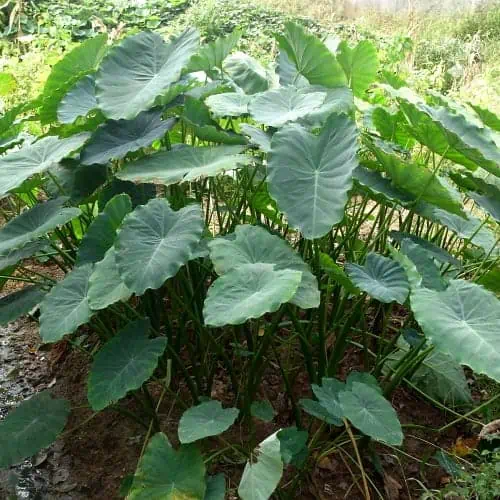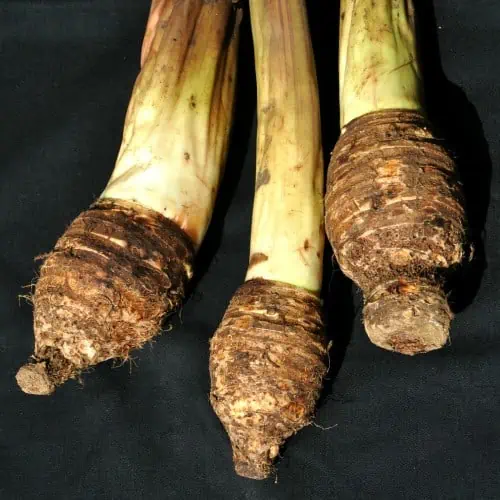
The cultivation of this famous root crop goes back several centuries. It’s near impossible to travel throughout South Asia without coming across the humble taro. Known by dozens of different names in several languages, this vegetable is also known as yam, dasheen, ube, kalo, edo, and elephant’s ears. It is one of the most widespread species of the Araceae or arum family, which are distinguished by their unique inflorescences and starch-rich corms.
Even the Pacific Islanders and several African cultures have developed a fondness for this large-leafed crop. Native to South and Southeast Asia, taro populations have now become naturalized as far as the Americas. As C. esculenta is a polymorphic species, meaning its forms are highly varied within a single population, differentiating between wild and ornamental types can be challenging for unseasoned botanists.
Generally, taro is distinguished by its huge, heart-shaped leaves. These range in color from bright green to burgundy and arise on the tips of petioles that can grow as tall as 3 feet (91 cm) or more. The petioles sprout directly from buried rhizomes that come in a variety of sizes and forms. Largely composed of starch, the rhizomes facilitate the spread of the plant. The rare taro flower, taking on the form of a typical spadix, is somewhat inconspicuous compared to the leaves.
Taro Growth, Hardiness & Climate

C. esculenta thrives best in moist, well-draining substrates with a highly organic profile. Its large leaves benefit from full to partial sun exposure, but they should be protected from potentially destructive strong winds. Intense sunlight coupled with prolonged dryness of the substrate may also compromise the quality of the plant’s leaves and corms. However, taro is quite hardy to extreme (tropical) weather conditions, especially if its roots have taken firm hold of the soil.
If cultivating taro in shallow water, the soil and water pH should range between 5.5 – 6.5. Healthy taro specimens can tolerate mildly higher or lower pH levels outside of this range. As this is a tropical species, ambient temperatures should ideally range from 21 – 28˚C (70 – 82˚F). In temperate zones, taro may tolerate temperatures that dip to as low as 10˚C (50˚F) in winter. Growth yields tend to be higher under exposure to warmer conditions. Interestingly, taro can concentrate heat into its spadix, accentuating its scent. This makes it more appealing to potential pollinators.
Although the taro root system tends to have a limited underground spread in its native range, its suckers may compete with weak competitors. You may wish to grow this species in large, buried containers to limit its spread.
How to Plant Taro

As taro cultivars rarely produce seeds, which have a meager chance of being fertile to begin with, they are propagated via root division or with the use of corms. The large corms are typically harvested as food, whereas the smaller corms are more popularly used for cultivation. Sections of larger corms or suckers can also be used, as long as they are obtained from mature, healthy specimens. If you have no access to mature plants, you can propagate taro using grocery or market-bought corms. Make sure to choose corms that are devoid of mold or rotten tissues.
Try to locate the upper and lower halves of the taro corm. The upper part tends to have an eye-like structure or depression. This is the junction from which new petioles will arise. The lower part tends to be more pointed. Orient this down into the substrate when positioning the corm. If it is impossible to differentiate between the upper and lower halves, you may opt to plant the corm sideways. This will ensure that the new growths can easily make their way to the soil’s surface.
The corms should be planted around 2 – 3 inches below soil level. If planting multiple corms at once, create deeper furrows and adopt a spacing of at least 2 feet (61 cm) between each. Make sure to use a rich substrate and situate your propagation setup in a warm area. If planting taro outdoors, wait until temperatures have effectively warmed in spring. It may take up to 200 days for a single plant to grow into its mature form.
How to Care for Taro

The key to producing healthy taro plants is by providing them with consistent moisture and by enriching the soil. Ideally, the substrate should be liberally mixed with organic matter. A general liquid fertilizer may be provided throughout the growing season. Regularly monitor the substrate around each taro plant and remove any weeds before they can grow to a considerable size.
If your C. esculenta is located in a greenhouse or indoor space, it may be necessary to mist the leaves regularly. A foliar fertilizer can also be used for supplementary nutrients, and a substrate fertilizer should be applied prior to planting the corm. Closely observe the leaves for any pests, such as aphids and spider mites. Manually remove these before they can reproduce and generate considerable colonies. If the leaves begin to appear yellow or brown, the corms may be ready for harvest.
If leaf damage occurs in the early stages of growth, check the roots of the plant. If they appear healthy, it’s likely that the soil is too nutrient-poor to sustain healthy expansion. Leaf damage may also occur due to low temperatures, excessive heat, pH imbalances, or fungal disorders.
How to Winter Taro
Taro is highly averse to frost and is unlikely to survive through cool winters outdoors. In warmer temperate zones, it may be enough to cut down any wilted petioles and mulch the soil. In northern temperate zones, horticulturists may prefer to treat this species as an annual. They uproot the corms just before the first frosts occur or once the leaves of the plant have begun to die back due to decreasing temperatures.
To properly store taro corms through winter, carefully shake off the soil and remove the roots. You can also use a damp cloth to thoroughly wipe them clean. Allow the corms to dry in a brightly lit area for a few days. Do not store them if they are coated with excess moisture as this may induce the growth of molds. Once their surfaces are sufficiently dry, you may individually wrap them up with porous materials, such as old newspapers or paper bags, and place them in a container that is filled with peat moss or wood shavings.
Place the container in a cool, dry, and dark location. The area should ideally be free of frost through winter. Once ambient temperatures have increased in spring, you may unwrap the corms and plant them.
Is Taro Invasive or Toxic?
C. esculenta is considered an invasive species in many areas, particularly in the US. There are many cases where populations have expanded beyond the range for mass cultivation. As a result, there are now wild stands of taro that aggressively compete with native plants for space and nutrients. This species has officially been listed as an invasive plant in Hawaii, Florida, Singapore, Taiwan, New Zealand, Queensland, and more.
It is also important to note that this potential weed is toxic in its raw form. Raphides (calcium carbonate crystals) and calcium oxalate salts are found throughout the plant. Fortunately, these toxins are easily neutralized by cooking the plant. When handling the corm and leaves, make sure to use gloves, as exposed tissues may cause skin irritations.
Is Taro Edible? Do Animals Eat it?
Primarily, the cooked corms of C. esculenta are highly edible and are a rich source of natural sugars. The leaves are also palatable when cooked. They contain considerable amounts of vitamins A & C, and they are fairly rich in protein as well. Many cultures cultivate taro as a staple crop and regard the corms as a main source of important nutrients.
Raw taro is highly problematic for animals as the salts and crystals may cause adverse digestive symptoms. Ensiled taro may be palatable to livestock. Wildlife will generally avoid consuming this plant if there are other, easily accessible herbs. Always keep an eye on your pets if they are free to roam in areas with wild or ornamental taro colonies. Ingestion of the raw plant is known to cause toxicosis in cats and dogs.
Where to Buy Taro & Seeds? (UK & US)
Colocasia esculenta can be purchased as corms or fully grown plants in garden centers and markets throughout its native range and in areas where it has become naturalized. Elsewhere, it is likely found in plant stores that carry tropical species and in specialty groceries that carry Asian ingredients. The corms tend to resemble other types of root crops, so double-check the name of the plant/vegetable before making a purchase.
In areas where C. esculenta has been declared an invasive species, it may be illegal to cultivate its corms. When in doubt, always check your locality’s list of prohibited plants and look for native alternatives to foreign species.


How can i get taro seeds. I am from pakistan .